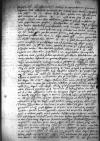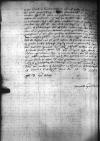1532-08-05⌊Hesterna nocte1532-08-05⌋ misit mihi generosus dominus et frater meus ⌊Nicolaus Nybschicz⌋ ⌊⌋ Illustris Dominationis Vestrae 1532-07-31⌊ultima(!) Iulii1532-07-31⌋ datas, quibus meis respondet, quas dedi novissime ad Illustrem Dominationem Vestram. Misit et eas, quas ad illum scripsit. Quod meam ⌊hinc⌋ absolutionem spectat et quando ea factura est, certo perscribere non possum, quandoquidem ⌊serenissima maiestas regia⌋ priusquam hinc versus ⌊Nepolomicz⌋ proficisceretur, mihi iniunxit, ut hic reditum suum praestolarer. Cuius voluntati mihi reluctari non licuit, venturaque est ⌊serenissima maiestas eius⌋ pro 1532-08-09⌊die Veneris futura1532-08-09⌋, unde quamprimum me hinc explicare potuero cum bona ⌊serenissimae regiae maiestatis⌋ gratia, omnem operam dabo, ut alicubi inter eundum Illustrem Dominationem Vestram (quod summopere cupio) coram complecti et pro desiderio meo ad sacietatem usque alloqui possim. Interea vero, ne Illustrem Dominationem Vestram ulterius de mente ⌊serenissimae caesareae maiestatis⌋ suspensam teneam, illam brevibus explicabo. Cum mihi a ⌊serenissima maiestate caesarea⌋ erat abeundum, postulavit a me, ut quibusdam principibus apud nos viris, quibus scribere intenderet, quo illorum benevolentiam obtineret, quaedam referenda non gravate susciperem, et inter primos Illustrem Dominationem Vestram commemmoravit, iniungens mihi, ut Illustri Domationi Vestrae ⌊suae maiestatis nomine⌋ salutem et singularis favoris et benevolentiae suae propensionem dicerem, illique omnia fausta precarer, commoneremque Dominationem Vestram, ut apud se reputaret, quibus in angustiis et discriminibus Respublica Christiana versaretur, hoc potissimum tempore, utque Dominationem Vestram nomine ⌊maiestatis suae⌋ hortarer et rogarem, quantum posset mutuum amorem et fraternam coniunctionem, quae est inter ⌊illum⌋ et serenissimum fratrem suum ⌊regem Romanorum⌋ et ⌊serenissimum regem ⌊Poloniae⌋⌋, dominum meum clementissimum, sedulo confirmaret, et opera sua auctiorem redderet, et rebus ⌊fratris sui⌋, ubi posset, apud ⌊serenissimum regem nostrum⌋ adesset, illudque apud se perpenderet, utrum magis rebus Christianis expediret, quod communis noster hostis ⌊Turca⌋ cum illis, qui se ei ultro addixerunt, nobile hoc ⌊Hungariae regnum⌋, ex quo perpetuae in vicina Christiana regna et dominia metuendae essent excursiones, haberet, an ⌊ille⌋, qui omnium
iure atque etiam ratione ⌊coniugis suae⌋ ad illud sit legitime assumptus quique hoc regnum posset validius quam quispiam alius contra ⌊Thurcae⌋ tyrannidem et vires tueri, et quem maiestas sua fratrem utpote suum germanum numquam posset deserere, et ob quem in ea Christianitatis parte retinendum facilius concilium generale, maxime his temporibus necessarium, statui et celebrari posset, in quo primum dissidiis religionis sopitis communis omnium Christianorum consensu contra communem hostem expeditio fieret, ⌊Graecia⌋que et alia Christianitatis Regna ex faucibus truculenti istiusmodi tyranni eriperentur. Quo tam pio et necessario negotio ⌊maiestas sua caesarea⌋ numquam esset defutura. Iniunxit mihi itaque maiestas sua, ut Illustrem Dominationem Vestram et quosdam nostros alios primores rogarem, quo huic tam expedienti proposito afficerentur, et hoc in primis Illustri Dominationi Vestrae, quae non immerito rebus ⌊regni Poloniae⌋ bellicis praeest atque apud ⌊serenissimum regem nostrum⌋ auctoritate sua valet plurimum, commendarem. Ubi vicissim ⌊maiestas sua caesarea⌋ Illustri Dominationi Vestrae gratificari et pro commodi ac honoris accessione usui esse posset, obtulit se erga Illustrem Dominationem Vestram propensissimam . Hoc quemadmodum serenissima ⌊caesarea maiestas⌋ referendum Illustri Dominationi Vestrae a me postulavit, in notitiam Illustris Dominationis Vestrae deducendum existimavi, ea vero, quae de Illustri Dominatione Vestra virtutibusque eius innumeris ⌊caesareae maiestati⌋ coram praedicavi, non est praesentis instituti recensere. Si Illustris Dominatio Vestra ad ista, quae scripsi ⌊serenissimae cesareae maiestati⌋ cum illi equos, de quibus scripsit domino ⌊Nybschicz⌋, mittet, respondere voluerit et suam ad ea propensionem declarare, faciet procul dubio rem ⌊caesareae maiestati⌋ gratissimam et qua suam excelsam exestimationem a me toties praedicatam augebit plurimum. Scribo hic cuidam singularissimo domino et amico meo ⌊domino de Nassau⌋, qui est apud ⌊caesarem⌋ de primis, et non habet minus quam centum millia ducatorum singulis annis in proventibus, item et domino secretario primario ⌊caesareae maiestatis⌋ ⌊Alfenso(!) Valdesio⌋, ut cum istius modi famuli Illustris Dominationis Vestrae cum equis ⌊caesari⌋ dandis ad curiam applicuerint, illos et munus Dominationis Vestrae omni favore apud ⌊caesaream maiestatem⌋ prosequantur, quod illos facturos omnino mihi persuadeo. Si qua alia in re Illustri Dominationi Vestrae gratificari et inservire possum, nihil est, quod facturus sum libentius. Cui me totum commendo, Christus Dominus noster Eandem quam diutissime incolumem et felicissimam conservet.

